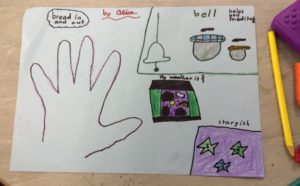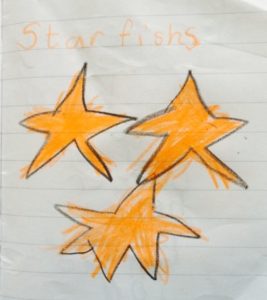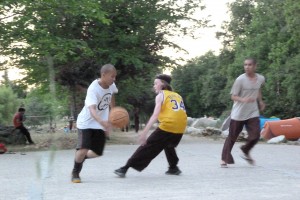This practice is inspired by Thich Nhat Hanh and the Plum Village Community’s teachings on getting in touch with our breath. Through her personal practice and five years with the children’s sangha in Dublin, Orlaith O’Sullivan narrates this variation called ‘Starfish’.
This practice is recognized by mental health practitioners as an anxiety reducer. We add a physical movement to Thay’s guidance on following your breath in order to bring mind and body together with a sense of ease. It’s creative, simple and beneficial for all ages.
The practice helps us to short-circuit our thinking and non-stop mental commentary, and trains us to rest our focus on our bodies. With children, it engages them imaginatively and gives them a simple, ever-moving practice to help build their muscle of attention. The name really captures the imagination of young children – older ages may respond better to ‘Tracking your Breath’ or ‘Finger Breathing’.

Starfish can help the challenges that we face at any age – whether we’re over-excited about a birthday party or worried in the middle of the night. It helps us unhook from strong emotions and addictive thinking, and come back to our body in this moment. We offer calm and peace to ourselves, and gain space around a difficult thought or feeling.
The Exercise
Choose a hand to be your starfish, and a finger to be your breath pointer.
Start below your thumb, down at your wrist, and wait for your next in breath.
As you breathe in naturally, trace your in breath carefully up your thumb with your finger. You need to time it so that you’re at the very tip of your thumb when your in breath becomes an out breath.
Let your breathing be totally natural. Your tracing finger is simply representing the breath along your hand.
Breathe down your thumb for your out breath, so that you’re at the very base when your out breath becomes an in breath
Remember – no messing with your breath! Simply speed up or slow down your tracing finger.
Breathe up and down each finger, with care and deliberate focus. Let yourself rest in the sensation of movement – your lungs breathing and your finger moving. As you breathe down your little finger, rest at the base of your wrist for a moment. Check in and see how you’re feeling. Simply notice the feelings – there’s no need to judge or explain anything. You’re just looking.
Then swap hands.
Settling at your wrist, wait for an in breath and repeat the process, leisurely tracing your breath up and down your fingers, in and out. Pause again at your wrist. How are you feeling? Again, simply notice and label. There’s nothing to fix.
Once you have learned Starfish, your body can respond very quickly to the practice, immediately settling in to the sensation of breath and touch. We learn that this is an appropriate moment to rest in our body and focus on ourselves.It helps us remember that we’re okay.
Creative Context for Educators

Before trying the practice, you can take time to talk about starfish
as a group. Who’s seen a starfish? What colours might they be? How many legs do they have? Does anyone know any interesting facts about starfish?
You can listen to each other’s experiences and ideas, and also draw your own starfish. This catalyzes our imagination, and helps us to view nature (and ourselves) with compassion as we learn this exercise.


